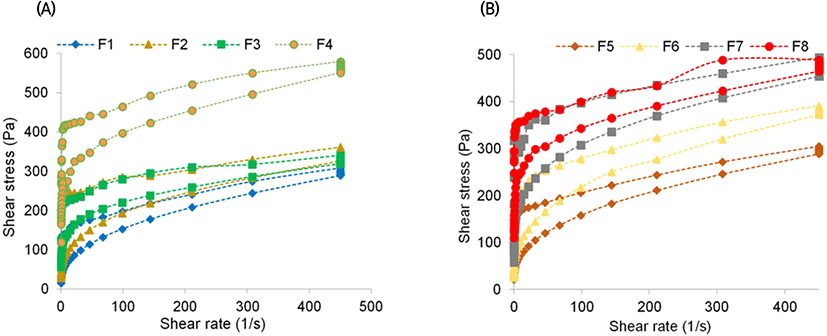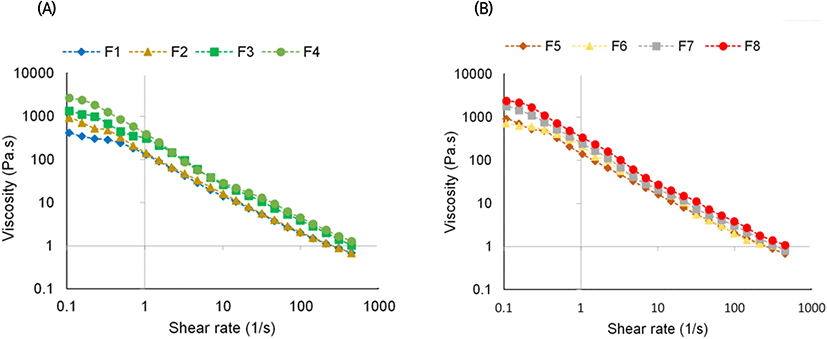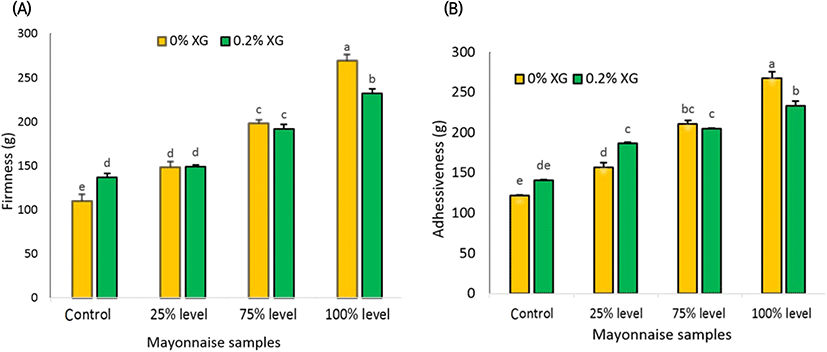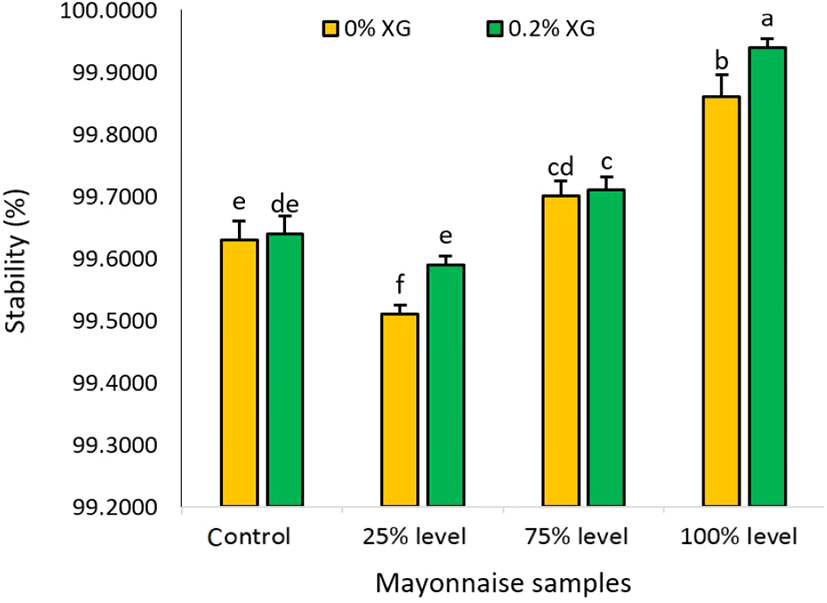1. Introduction
Mayonnaise is defined as an oil-in-water emulsion consisted of raw materials such as vegetable oil, egg yolk, vinegar, and other additives including egg white, salt, spices, stabilizer, thickener, etc. Among these, eggs have a unique role due to their high nutritional value and multifunctional properties, including emulsification, coagulation, foaming and flavoring (Narsimhan and Wang, 2008; Sathivel et al., 2005). Egg yolk has the surface-active moieties (i.e., lipovetlin, lipovitellin, and lutein) that adsorb at the oil-water interface and produce a film around the oil droplets, preventing coalescence (Breeding and Beyer, 2000; Yang and Baldwin, 1995). Therefore, egg yolk is an essential emulsifier for stabilizing many food emulsions such as mayonnaise.
However, many consumers are reluctant to consume egg-containing products because of the high cholesterol in egg yolks, which has been a main problem for many years. On the other hand, egg replacement in food systems reduces allergens, expensive ingredients, and microbial concerns and increases the shelf life of products. Therefore, there is a desire to replace eggs in the food systems (Liu et al., 2007; Swaran et al., 2003). Proteins can improve the surface activity of the emulsions by producing a protective steric barrier around the oil droplets (Dickinson, 1997; Prakash et al., 1990; Su et al, 2021). Some proteins such as soy protein (Rir et al., 1994) and whey protein (Herald et al., 2009; Takeda et al., 2001), have been recognized as the desirable emulsifying agents in oil-in-water emulsions.
Wheat germ is a byproduct of the flour mill industry, which is the most nutritious part of the wheat and is known as one of the most potential and important sources of minerals, vitamins, protein, and fiber at a relatively low cost (Nichelatti and Hidvegi, 2002; Skendi et al., 2020; Zhu et al., 2006). DWGF, after extraction of the valuable wheat germ oil, is a protein-rich material with high nutritional value, containing about 30% protein (mainly in the form of albumin and globulin), which shows the significant functional properties (Gomez et al., 2012).
Due to its favorable solubility, high emulsifying activity, hydrophobicity, and foaming capacity, this protein has become a key ingredient for various types of food products (Ge et al., 2000; Hassan et al., 2010). Application of DWGF and wheat germ protein isolate have been reported in cereal and bakery products such as cookies (Arshad et al., 2007), macaroni (Pinarli et al., 2004), and toast bread (Sidhu et al., 1999) and in biscuits and yogurts (Fatma et al., 2010). In the case of low-fat mayonnaise, the utilization of proteins including whey protein isolate (Herald et al., 2009) and wheat protein with some thickeners (Abu Ghoush et al., 2008) has been reported as egg yolk substitutes. In the latest researches, many authors have discussed the replacement of eggs with different ingredients such as soybean oil body (Wang et al., 2022), faba bean protein (Ouraji et al., 2020), physically modified corn flour (Carcelli et al., 2020) and physically refined rice bran oil and filtered sesame oil (Chetana et al., 2019) in mayonnaise formulation. However, there is no much information on the use of DWGF in low-cholesterol mayonnaise as an egg yolk substitute. DWGF also contains high nutritional value protein material with unique functional properties that is lost as annual waste during milling. Therefore, this research was conducted with the aim of evaluating the use of DWGF at different levels alone or in combination with XG as an egg yolk substitute to determine the stability, textural, rheological and sensory characteristics of mayonnaise.
2. Materials and methods
Raw wheat germ (RWG) was obtained from Gorgan Flour Factory (Gorgan, Iran). XG was obtained from Sigma-Aldrich. Other raw materials of the mayonnaise including vinegar, vegetable oil, sugar, salt and mustard powder were purchased from the local market.
Raw wheat germ was sieved and waste material including bran were removed, then defatted with hexane (1:10 w/v) for 8 h and air-dried until all the added hexane evaporates at room temperature (25℃). DWGF meal was milled by a laboratory scale hammer mill (Perten, 3100, Hamburg, Germany) and the obtained flour (DWGF) was sieved by a 100 mesh screen.
The mayonnaise samples were produced by the basic formulation which is now produced commercially. The control mayonnaise (F1) contained the following ingredients (w/w): vegetable oil 65%, egg yolk 9%, vinegar 7% (11% w/v acetic acid), salt 1%, sugar 5%, mustard 0.3%, stabilizer 0.15% and water 12.55%. As shown in Table 1, the other mayonnaise samples were prepared by replacing the egg yolk with DWGF alone or in combination with 0.2% XG. The mayonnaise samples were prepared using a standard mixer (Kenwood, AW34655, Bad Vilbel, Germany). In order to mayonnaise preparation, the DWGF and/or egg yolk, and half of the water were mixed together for about 2 min, followed by the addition of the dry matters (sugar, mustard, salt and stabilizer). Then a small portion of the total oil was added. The ingredients were admixed for about 5 min. Then, one third of vinegar was gradually blended in the mixer. Finally, the remaining oil, water and vinegar were slowly added and admixed in a blender. The prepared mayonnaise samples were poured into glass bottles and placed in refrigerator (at 4°C) until the analysis.
| Samples1) | Egg yolk (dry matter %) | DWGF (dry matter %) | Xantan (g) |
|---|---|---|---|
| F1 | 100 | 0 | 0 |
| F2 | 75 | 25 | 0 |
| F3 | 25 | 75 | 0 |
| F4 | 0 | 100 | 0 |
| F5 | 100 | 0 | 0.2 |
| F6 | 75 | 25 | 0.2 |
| F7 | 25 | 75 | 0.2 |
| F8 | 0 | 100 | 0.2 |
The analyses of RWG, DWGF and prepared samples such as moisture, protein, and ash content were determined by AOAC methods (2005). Fat percent of prepared samples was detected by the method of Bligh and Dyer (1959).
A rheometer (Physica MCR 301, Anton Paar, Graz, Austria) was used for rheological analyses. The flow behavior of mayonnaise samples was investigated by a parallel stainless steel plate with a diameter of 20 mm, in the shear rate range of 0.05-450/sec at a temperature of 20°C. In order to investigate the thixotropic behavior, current curves were drawn in strain-controlled mode from 0.05 to 450/sec in 100 seconds. Then this shear rate (450/sec) was continued for 100 seconds and then the shear rate was reduced to 0.05/sec again in a period of 100 seconds.
After the test, the obtained experimental data were fitted with some common and relevant mathematical equations or models to find the rheological parameters. To describe the flow behavior of the prepared samples, the obtained experimental data were fitted with the Herschel-Bulkley equation (eq. 1):
Where, τ, γ, K, n and τ0 are the shear stress (Pa), shear rate (1/s), consistency index (Pa.s), flow behavior index and yield stress (Pa), respectively.
The dynamic oscillatory analyses were carried out at the frequency ranges of 0.1-50 Hz at a constant strain of 0.5 (within the strain sweeps was performed previously for determining the linear viscoelasticity range). A rheometer software program was used to analysis of the collected data and calculate the rheological parameters. Tan delta, storage modulus (G') and loss modulus (G") were calculated versus frequency for all the produced samples (Rahbari et al., 2014).
The TA.XT2i Texture Analyzer (Stable Micro Systems Ltd., Surrey, UK) equipped with a 25 kg load cell was used for the texture measurement of samples. A back extrusion cell with 35 mm diameter compression disc was also used. The produced samples were poured into acrylic cylindrical containers carefully (with 75 mm height and 50 mm internal diameter) to a depth of 50 mm. A cycle was performed, at a constant crosshead velocity of 1 mm/s, to a sample depth of 40 mm, and then returned. The values of texture attributes such as firmness and adhesiveness were obtained from the resulting force-time curve by texture software. As described by Worrasinchai et al. (2006), firmness was the maximum force as the test cell penetrated into the sample. Also, adhesiveness was defined as the negative force area, indicating the work necessary to pull the compressing plunger away from the sample (Bourne, 1978).
15 g (W1) of each sample was poured into the tube tests (15 mm internal diameter, and 125 mm height) and tightly sealed with plastic caps and centrifuged at 5,000 rpm for 30 min (Hanil, combi 514 R, Korea) in order to separate the oil layer collected in the top. After discarding oil layer, the weight of the precipitated fraction (W2) was also recorded. The emulsion stability of produced samples was defined as:
3. Results and discussion
Table 2 shows the proximate chemical composition of RWG and DWGF. A relatively high level of protein was reported in DWGF compared with RWG (31.42%, and 27.71% respectively). Due to the removing of fat, a significant (p<0.05) reduction of fat is observed in wheat germ (from 10.49 to 0.75%). Also, a high level of carbohydrates was detected in RWG and DWGF (56.37 and 53.27%, respectively). The previous findings by Zhu et al. (2006) are consistent with this results.
The proximate composition and caloric values of mayonnaise samples are presented in Table 3. The protein and ash content increased with increasing the levels of egg yolk substitutes significantly (p<0.05) due to the high protein and ash content of DWGF (Hassan et al., 2010). However, the significant differences were not observed for moisture, fat, and carbohydrate contents of the produced samples. In terms of caloric values, all mayonnaise samples were in the similar ranges and no significant difference was observed. In fact, the lack of significant differences in the carbohydrate and fat content of the mayonnaise samples is a possible reason for this.
F1-F8 refer to Table 1.
The flow curves of steady state of the different mayonnaise samples are shown in Fig. 1. The thixotropic behavior was observed for all investigated mayonnaise samples over the all ranges of the studied shear rate (0.05-450/sec) as the segments of the up curves reached values of shear stress higher than those of the down curves at the same values of shear rate. Similar results were reported earlier (Liu et al., 2007; Worrasinchai et al., 2006). Flow properties showed that the thixotropic shear thinning in all samples depended on both time and shear rate. In high-viscosity emulsions, the formation of a three-dimensional network of aggregated droplets was observed due to flocculation. A progressive deformation and disruption of the aggregated particles created by shearing of emulsion and this can led to a decrease in emulsion resistance to flow and its apparent viscosity over time (McClements, 2005).
The thixotropic loop was drawn by increasing, maintaining and decreasing the shear rate for each sample. As shown in Table 4, mayonnaise samples containing 100% egg yolk (F1 and F5) exhibited the highest values of thixotropic hysteresis loop (p<0.05). Moreover, the lowest thixotropic hysteresis loop was observed in F4 and F8 containing 100% DWGF as egg yolk substitute. In general, all mayonnaise samples containing DWGF represented lower thixotropic hysteresis loop than control (F1) so that the hysteresis loop decreased by increasing the egg yolk substitution. Thus, egg yolk showed the more increase in thixotropic behavior compared to the DWGF as the emulsifying agent in the absence of XG. In general, the hysteresis loop of mayonnaise samples containing XG was lower than that of samples without it at each substitution level.
| Samples1) | F1 | F2 | F3 | F4 | F5 | F6 | F7 | F8 |
|---|---|---|---|---|---|---|---|---|
| Thixotropy (Pa/s) | 23,241.512)a | 21,768.17b | 19,083.25d | 17,246.99e | 22,342.67ab | 20,342.67c | 17,042.41e | 16,399.97e |
F1-F8 refer to Table 1.
The flow properties of mayonnaise samples properly explained by the Hershel-Bulkley model. Table 5 shows the model fitting with flow equation parameters of different mayonnaise samples. The presence of a finite yield stress required to achieve flow is an important property of the Hershel-Bulkley equation which is essential in mayonnaise quality, particularly when they used in salad dressings to maintain the ability to adhere to the product surface. The Hershel–Bulkley equation showed that the F4 (100% DWGF) had the highest yield stress (146.63) among all samples (p<0.05). On the other hand, those samples formulated with DWGF and XG demonstrated higher values of yield stress compared to samples with egg yolk. Since the volume fraction of disperse phase is constant, the viscosity of the aqueous phase was increased by the addition of XG to DWGF. In addition, protein–polysaccharide interaction remarkably reduces the interfacial tension between the oil and water and produces a thick interfacial layer on oil droplets and these resulted in a stable emulsion with small oil droplets which increased yield stress.
F1-F8 refer to Table 1.
The pseudoplastic fluids were recognized for the samples in the range of 0.19-0.42 by evaluating the flow behavior index values (n) (Table 5). Fig. 2 shows that the apparent viscosities of all samples decreased with increasing shear rates and rheological behaviors of all samples were shear thinning. Recently, other researchers also reported similar results that increasing the soybean oil body substitution ratio resulted in decreases in the apparent viscosities of the mayonnaise samples, which is probably attributed to the higher water content in soybean oil body (Wang et al., 2022; Werlang et al., 2021).
The consistency coefficients (K) of the samples ranged from 21.32 to 79.23 Pa.s (Table 5) and the K values of the samples were also remarkably different based on the mentioned Hershel–Bulkley parameters. The highest K value was observed in F8 (100% DWGF and 0.2% XG), which indicates a more viscose fluid (Laca et al., 2010). The Hershel-Bulkley equation showed that the F8 had the highest consistency coefficient (77.77) among the all samples (p<0.05). In other words, samples formulated with DWGF and XG demonstrated higher values of consistency coefficient compared to samples with egg yolk.
Sathivel et al. (2005) was also founded similar results that a shear thinning behavior was obtained in the mayonnaise produced from arrowtooth flounder soluble protein powder as egg yolk substitute and recognized pseudoplastic and viscoelastic characteristics for produced samples. Furthermore, a shear thinning behavior was observed in all evaluated mayonnaise samples containing xanthan gum and lupin protein (Raymundoa et al., 2002). Mun et al. (2009) also reported a shear thinning behavior in all mayonnaise samples with xanthan gum and 4αGTase-modified rice starch and the largest values of yield stress in mayonnaise with gum in all samples.
Dynamic flow analyses can be applied to determine the viscoelastic characteristics of mayonnaise. According to obtained results from the dynamic test, the produced mayonnaise samples grouped into the weak gels, because G' was larger than G" in all-tested frequency range and increasing the frequency led to a gradual increase in G' (Fig. 3). On the other hand, since tan delta was less than 1, the mayonnaise samples have a solid-like viscoelastic behavior. The other researchers also confirmed that mayonnaise showed weak gel characteristics in the frequency range of 0.1-10 Hz (Mancini et al., 2002; Mun et al., 2009; Sathivel et al., 2005). In recent research, similar results were found for mayonnaise formulated with sesame and peanut defatted-meal milk as egg yolk substitute. A shear thinning flow with higher G' compared to the G" (tan δ<1) is reported in low-angular frequencies, while tan δ was more than 1 (i.e. G">G') in angular frequencies higher than 63 rad.s−1 which was indicated the more G" (liquid-like flow behavior) compared to the G' (gel-like flow behavior) in the higher content of substitutes (Karshenas et al., 2019).
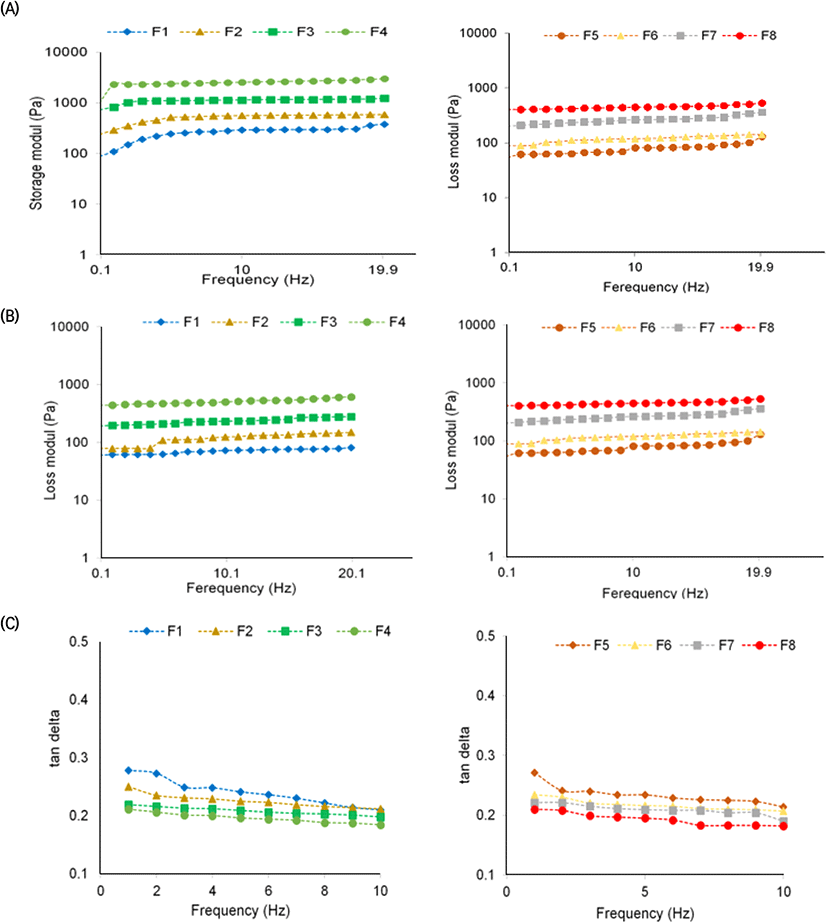
According to Fig. 3, G' was increased in mayonnaise samples containing higher amounts of DWGF (F4 and F3) as well as in the mayonnaise containing XG (F5-F8). Based on the obtained results, the F4 and F8 had the lowest tan δ values (p<0.05). Also, due to the presence of the gum, they were more solid than viscoelastic reinforcement through increased interactions between the protein and stabilizing molecules, as described in several cases. The addition of gum itself may increase the elasticity of the emulsion and based on these results, it can be claimed that the combination of DWGF and XG can improve the elasticity of the emulsion by forming a strong gel-like structure in the continuous phase, as well as making the diameter of the oil droplets smaller due to the reduction of the coalescence process during emulsification.
Based on the texture analysis results, mayonnaise with 100% egg yolk replacement (F4), showed the hardest structure, while the lowest firmness value was obtained in control (F1) containing 100% egg yolk (p<0.05) (Fig. 4). In addition, the highest adhesiveness value occurred in the sample with 100% DWGF (p<0.05). Generally, samples with higher contents of DWGF and XG, had more adhesiveness and firmness compared to the samples with egg yolk. These results were probably obtained due to the more viscosity of the emulsions with high contents of DWGF and XG. The obtained viscosity values of the samples can partially indicate the texture analysis parameters (Liu et al., 2007). The thickening properties of gums may led to an increase in viscosity, which may postpone the migration rate of oil droplets in turn (Chouard, 2004). The combination of protein and gum, as an egg yolk substitute, can increase the viscosity and form a stable O/W emulsion, and thus, the oil droplets are separated by the protein-gum particles and aggregation is reduced compared to the formulation with egg yolk (Abu Ghoush et al., 2008).
Other results have been reported in the literature, for example, a low-cholesterol mayonnaise formulation stabilized with mixed gum and wheat protein isolate as an egg substitute which in the firmness value is increased with raising the protein and gums concentration (Herald et al., 2009), In another research, the addition of Chia (Salvia Hispânica L.) mucilage promoted the texture parameters of mayonnaise by oil substitution the substitution of egg yolk in mayonnaise reflected the similar texture parameters with the control samples (Fernandes and Mellado, 2018). In addition, textural parameters including apparent viscosity, hardness, adhesiveness, adhesive force, and hardness improved by raising the amount of Farsi gum (Mousakhani-Ganjeh and Goli, 2021).
Emulsion stability usually indicates preventing the droplets from creaming, coalescence or flocculation. Because the droplets are very close together and do not move freely, emulsions with high fat levels are mostly stable (Mun et al., 2009). Mayonnaise samples with the minimum content (65%) of required fat for the formulation of a commercial mayonnaise reflected proper stability. The emulsion stability increased significantly (p<0.05) by addition of DWGF (Fig. 5). In general, the best stability value was recorded for the sample formulated with a higher level of XG and DWGF (F8).
These results suggest that the prepared formulations may improve the polysaccharide-protein interaction and can have the variable effects on stability and rheological properties. It may be caused by increasing the viscosity of the aqueous phase by xanthan gum with DWGF to prevent the mobility of the droplets, in which case the protein-polysaccharide interaction reduces the surface tension of oil and water remarkably and forms a thick surface layer on the oil droplets and finally produces a stable emulsion. These results confirmed the other applications of iota-carrageenan and wheat protein as an emulsifier substitute for egg yolk to stabilize the emulsion in the mayonnaise samples (Abu Ghoush et al., 2008). Herald et al. (2009) optimized the formulation of low cholesterol mayonnaise by fenugreek gum and whey protein concentrate at 100% and 50% substitution and obtained similar results.
Different results have been reported in recent research in which soybean oil body caused a decrease in apparent viscosity and stability of the mayonnaise samples because of the higher moisture level (Wang et al., 2022a). Furthermore, soybean oil body-substituted mayonnaise showed better bacteriostatic property and oxidative stability compared to the full egg yolk mayonnaise (Wang et al., 2022b). Finally, a significant difference was observed in the physical stability of emulsion in the samples with equal content of Faba bean protein and egg yolk powder in comparison with the conventional formulation (Ouraji et al., 2020).
4. Conclusions
Based on the obtained results, it can be found that defatted wheat germ flour can be used as an egg yolk substitutes in mayonnaise. The combination of defatted wheat germ flour and xanthan gum as egg yolk substitutes improved the textural and rheological properties and stability. However, Mayonnaise with 100% egg yolk replacement showed the hardest structure, while the lowest firmness value was obtained in control containing 100% egg yolk. Also, the highest adhesiveness value occurred in sample with 100% DWGF. The thixotropic behavior was observed for all investigated mayonnaise samples over the all ranges of the studied shear rate (0.05-450/sec). Furthermore, the highest consistency coefficient value was observed in sample with 100% DWGF and 0.2% XG. The results of this study indicated that the optimal combination of defatted wheat germ flour and xanthan can be used to prepare low-cholesterol mayonnaise with the same characteristics as normal mayonnaise.

